A methodology, in the context of
project management, may be defined as a well-established system of logically related processes, techniques, rules and procedures followed by users in a certain discipline to determine the best way to plan, develop, control and deliver a project through continuous implementation to completion. Choosing the right methodology for a particular project in a distinct business area has a massive impact on the chance of getting the job done right, so this article will discuss five different methodologies and what they are best suited for. We will also explain how Stackfield, as a comprehensive project management software, can support the application of the respective methods.
Essentially, they are all sets of guidelines aimed at helping managers throughout a project and with completing individual tasks, with each one employing different strategies to overcome any problems that may arise during the delivery of the project. The type of industry as well as the type of the project are decisive when it comes to choosing the right project management method.
Lean
If you talk about Lean you’re probably talking about „waste reduction” at the same time. This methodology proceeds on the assumption that the value chain can be optimized by avoiding waste as far as possible. This, we assume, will ensure that customer benefit and price efficiency reach the highest possible level.
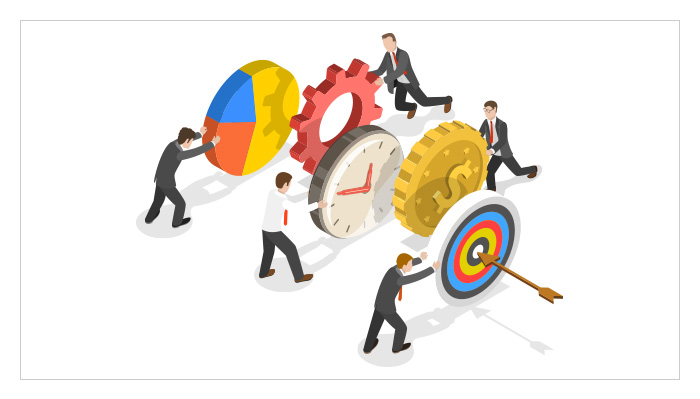
The value stream equally includes all value-adding and non-value-adding activities on the way to the completion of a product, resp. Project.
Features
Identifies three types of waste, known as the 3Ms of Lean production. Muda (waste), Mura (unevenness), Muri (overburden).
- Muda: All processes from with the product doesn’t benefit directly are said to be waste. Therefore, it is necessary to identify and eliminate the waste of resources in order to increase efficiency.
- Mura: However, a reduction in productivity can also be caused by uneven processes, as soon as the processes do not ideally mesh and capacities are not optimally utilized. Lean tries to ensure smooth processes by offsetting deviations on an operational and temporal level.
- Muri: Ultimately, Lean's goal is to prevent slowing processes that are caused by congestion. This can simply be stress through excessive labour but also mechanical overloads.
We assume the best possible utilization and thus the highest possible efficiency if neither Muda, Mura nor Muri exist.
Principles
Lean involves a five-step thought process for guiding the implementation of techniques that is "easy to remember, but not always easy to achieve":
- Specify value according to the customer’s point-of-view.
- Identify all the steps in the value stream and eliminate that do not create value, where possible.
- Organise the value-creating steps to occur continuously.
- Allow customers to pull value from the next upstream activity.
- Remove wasted steps and repeat the process again until a state is reached in which perfect value is created without waste.
What it suits best
Lean is no longer used only in the manufacturing industry. The philosophy can be applied in almost every area - for example, one can find concepts for lean leadership, lean supply chain, lean development, etc. It is important to understand that lean is not a classic one-fits-all solution , processes must be optimized on a case-by-case basis and tailored to the needs of the respective target groups.
How does Stackfield fit?
With Stackfield, you can easily identify bottlenecks and problems your team can encounter while completing tasks. For example, it can be determined by many expired tasks of a member, whether the respective team member is overloaded. Above all, there is no option for bad organization. Kanban board, detailed task descriptions and targeted communication prevent this.
Waterfall
As the name implies, the working process of the waterfall method can be compared to the steady downflow of a waterfall. You can easily see that by looking at the concept’s graphic representation which is based on the step-like flow of a cascade: continuous, sequential, flowing in one direction. Each step necessarily depends on the completion of the previous one.
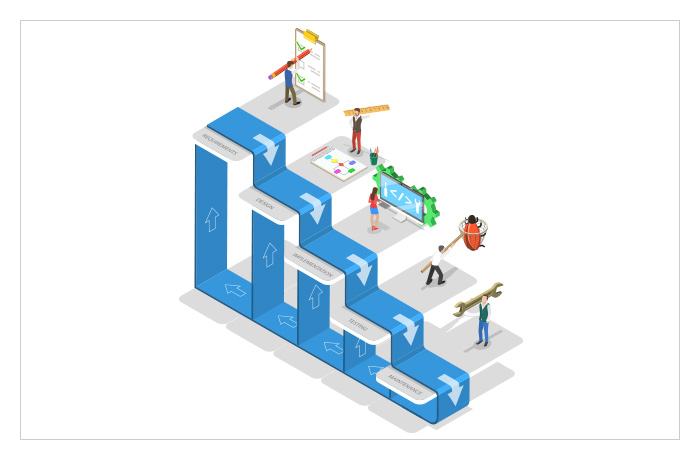
Features
The waterfall methodology insists that the current phase of development must be fully completed before moving on to the next stage. Without deliverables from the former stages, the project is stuck. The phases are not-moveable and must be completed in the order given below, without any further changes:
- System and product (software) requirements
- Analysis
- Design
- Coding
- Testing
- Operations
Principles
Because each step builds on the previous one, meticulous planning and the documentation of all stages of the process is what matters most in Waterfall. Hence, it is always necessary to compare all results with the previously defined requirements. Have all goals been accomplished? Furthermore, having recorded all the information accurately is also an advantage in case of short-term employee changes and outages. The documentation allows to follow all previous steps, making it extremely easy for new employees or agents to take on tasks.
What it suits best
Waterfall - being a very inflexible method - is suitable for familiar projects and processes where it is unlikely that problems will occur unexpectedly, as well as for shorter projects where individual stages are heavily dependent on the completion of others. The methodology originates from the manufacturing and construction industry, but since then it has been used in various areas of project management - for example, in software development. However, it should be noted that such a clear organization is not always feasible, especially with complex software developments. Spontaneous adjustments in the course of the project are not planned. Thus, the method stands in stark contrast to today's common agile methods.
How does Stackfield fit?
Requirements can be depicted in different ways. Information concerning the entire project can be stored in the documents or in the file module. This way, they stay visible for everyone anytime. Explicit information can be stored within in the individual tasks. All content can also be linked together. This makes it easier for the team to maintain relationships. The task board is well suited to illustrate the individual process steps and the current state of the project in general.
Agile
Agile project management is in stark contrast to the waterfall method. Rather than being it’s own method it is a generic term for a variety of agile approach methods that we will explore in more detail in this article.
The approach was developed to solve some of the problems that arise in software development in the context of classical methods. These include, in particular, its non-adaptiveness, delays in testing and the lack of customer / user feedback during the development process.
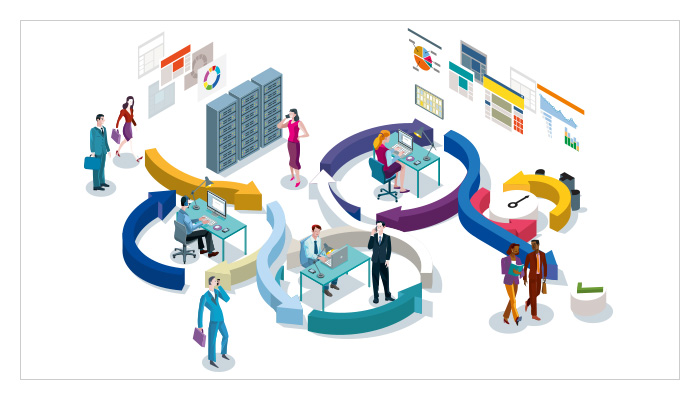
Principles
The Agile Manifesto, cemented as a public declaration by software development experts in 2001, outlines 12 principles. In particular, the principles call for flexibility and short-term adaptability based on a functioning feedback culture. A prerequisite for this is a motivating environment with flat hierarchies and an open communication in which all members are involved.
The Agile Manifesto establishes four core values according to which teams should value...
- individuals and interactions over processes and tools,
- functioning software over comprehensive documentation,
- cooperation with the customer over contract negotiation,
- responding to change over following a plan.
The difference to the waterfall method is quite clear: the flexibility of this method is in stark contrast to the rigid requirements of classical project management.
What it suits best
The area where Agile methods were first used - and the area where they are most common today - is software development. Other areas are by no means excluded. Due to the high flexibility, the method is suitable for all new (unknown), complex and large projects.
Scrum
Scrum is probably the method that is most commonly associated with agile projectmanagement. The basic idea behind this method arises from the assumption that "knowledge comes from experience and making decisions based on what is known."
Features
This statement also explains why flexibility is so important. It is because the process isn’t always predictable. Only if individual developments within the process are reflected, if feedback is openly accepted, and if there is the freedom to respond and to make adjustments, the right decisions can be made. For complex projects, this approach is essential.
The method uses an iterative incremental approach. What may sound a bit complicated at first means that we work progressively (iteratively) within regular cycles - so-called sprints – that end with a finished/usable intermediate product (the increment). Each sprint remains predictable based on the previous sprint. So you can also experiment without taking too much risk. Misconceptions only jeopardize the sprint increment, but not the entire project.
Structure
All guidelines can be found in the official Scrum Guide.
However, the fact that the project is flexible does not mean that no rules have been set and nobody knows what to work on. Quite the contrary: Scrum explicitely requires 3 artifacts, 3 roles and 5 events to maintain flexibility and transparency.
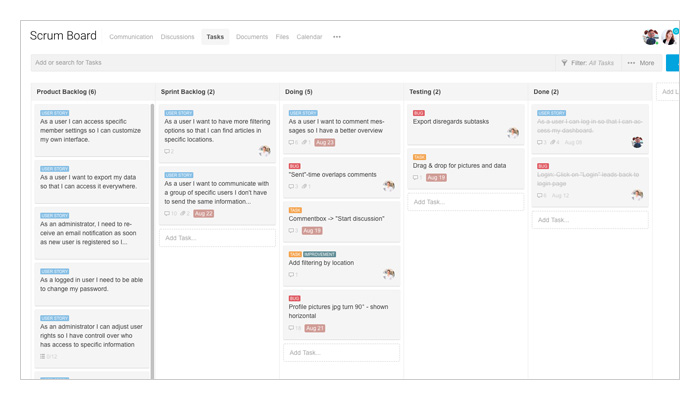
One of the three artifacts is the Product Backlog, a list of all requirements on the project that needs to be continuously maintained. Thereafter, some of these requirements wander into the Sprint Backlog to work on them during the upcoming sprint. This ultimately forms the last Artifact, the Product Increment. All requirements for this increment must be „done” by the end of the sprint.
The Scrum Team consists of a Product Owner who is responsible for the Product Backlog and represents the interests of Stackholders, a Scrum Master who is responsible for Scrum compliance, and the Developers Team whose goal is to get all the Sprint Backlog requirements done autonomously.
Finally, Scrum also sets some guidelines for the course of the sprints. The scrum guide uses five events, to do so. A sprint can be seperated into four events. At the beginning of each Sprint, a Sprint Planning takes place. Within this meeting the Product Owner sets the requirements and priorities for the sprint. Within the sprint, short daily meetings (15 minutes), called Daily Scrums, will be held to discuss the plan for the upcoming day and possible hurdles. Towards the end of the sprint the team will do a Sprint Review to present the final increment to the stackholders and to update the Product Backlog. Lastly, there will be a Sprint Retrospective held by the Scrum Master. Here, the focus lies on process optimization for future sprints. The Sprint itself forms the last event and should not last more than one month in total.
What it suits best
Scrum has found a firm place within the methods origin: the software development. By no means, however, it is confined to this area. Scrum is suitable for any project that is too complex to fully plan right from the start, and which is likely to require ongoing adjustments. The Scrum Guide also recommends small teams of up to 9 people to maintain a functioning team communication.
How does Stackfield fit?
Subtasks, labels, and file attachments can easily be assigned to the tasks, keeping all relationships intact. Detailed user rights options allow for customization of all Scrum roles. For example, you can specify who can move requests from the product backlog to the sprint backlog, and who can ultimately edit them. By having a quick look at the task board or the Dashboard one can easily make out bottlenecks and see if there are any tasks that are overdue.
Kanban
The one who talks about „Scrum” should not forget about „Kanban”. These two methods are among the most widely used project management methods. However, while Scrum's primary focus is to stay flexible for innovation and to keep risks in check, Kanban’s goal is to increase efficiency by avoiding multitasking.
Principles
Kanban provides little regulation. However, these three rules play a major role in successful implementation:
- Visualization of the workflow
- Limiting work in progress (Work-In-Progress, WIP for short)
- Measurement and optimization of the cycle time / processes
With the goal of completing the project as quickly as possible, but putting multitasking on a level with reduced productivity, there is a huge attention on a strict, step-by-step approach. One task after the other. Focus. This way, the lead time of individual project steps should be shortened.
Features
During the process, the cycle times continuously need to be checked and a WIP limit has to be set, i.e. the tasks in progress are being limited in quantity. At the center of the project management method is the visualization of the project steps by using a so-called kanban board. Incidentally, this is also used in other methods, phisically or digitally. The board has at least three "status columns" (to do / in progress incl. WIP limit / done). The goal is therefore to carry all tasks into the column "done".
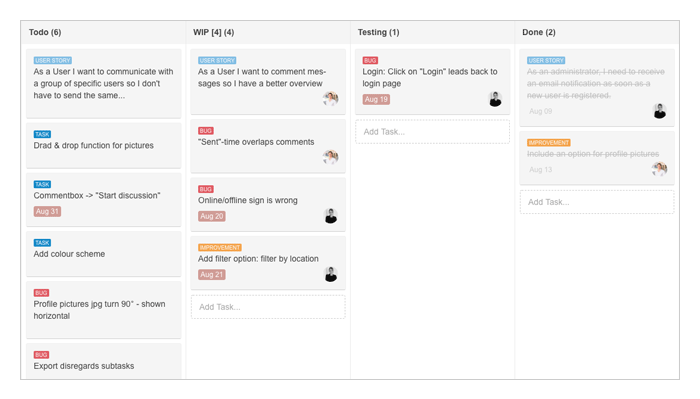
What it suits best
Because of its high flexibility Kanban is suitable for almost every project, as long as it is not too complex. The Kanban board is even used for private projects - such as for wedding planning – and it is suitable for both teams and individuals alike. However, if you want to experiment, tackle complex product development or if you expect unpredictable risks, Scrum may be a better choice.
How does Stackfield fit?
The flexible Kanban board is a central feature in Stackfield that helps to visualize project processes in various industries. It provides a quick overview of the entire project and leads you directly to bottlenecks (expired tasks, overloading of team members, etc.). With its detailed rights system and custom workflows, the board remains adjustable to a wide range of project types. In addition, reasonable links between the modules (tasks, files, documents, etc.) help to join the dots.
Critical Path Method
By using the Critical Path Method, you can depict all necessary process steps with regard to their dependencies on other steps / tasks. For example, an event planner would note that table set and decoration can not be chosen until the location has been determined. If the task 'choosing a location' is behind schedule, the project is likely to be slowed down to the same extent. The catering, on the other hand, can be ordered independently of these decisions. If we take a look at the graphic below, it becomes clear that the task 'choosing the catering' wouldn’t even affect the duration of the project if it took 15 instead of 9 days.
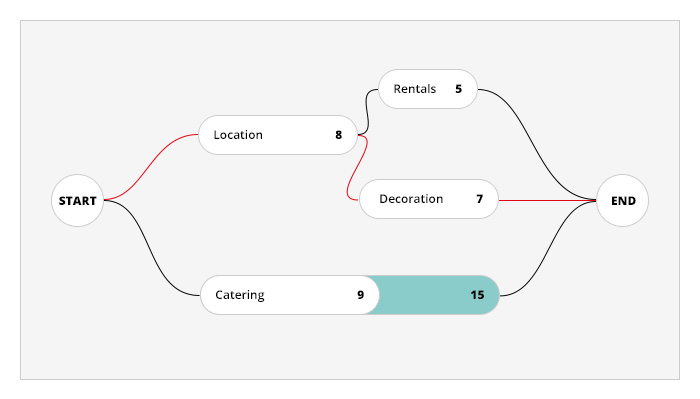
Thus, the critical path describes the longest chain of tasks to be completed, which at the same time represents the minimum time needed to complete the project. If the critical path lengthens or shortens, so does the entire project. This can be easily visualized using a PERT or Gantt chart.
Features
The goal of this method is to determine which tasks affect the length of the project the most and are therefore most important in order to properly schedule all tasks and meet deadlines. For other Tasks there may be time cushion. This way, the team is able to discover the fastest way finish the project.
Approach
In order to establish the Critical Path, you need to:
- make a list of all tasks required for the completion of the project
- mark the dependencies between the tasks
- estimate the duration of every tasks
- set milestones, if needed
What it suits best
A critical path analysis always makes sense when a project is a complex task structure with many dependencies. It helps to identify the steps that are critical and can lead to delays. However, it may be determined at what point the entire project could be accelerated.
But keep in mind: It is important to know that the critical path can change during the project.
How does Stackfield fit?
Dependencies between tasks and thus also the planed length of the project can be easily visualized using a Gantt chart, which will be available on Stackfield as part of the major update by the end of 2019.